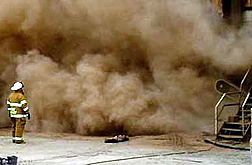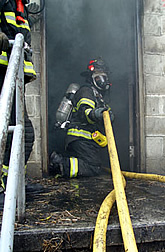This page has been archived and is being provided for reference purposes only. The page is no longer being updated, and therefore, links on the page may be invalid.
|
|
Smoke-Clearing Technology May Come From Poultry House Air Scrubber
By Kim KaplanApril 25, 2006
A device invented by the Agricultural Research Service (ARS) to clean dust and microorganisms from the air of poultry houses may also help people escape during fires and make it easier for fire fighters to locate people in smoke-filled rooms.
The technology was originally developed by ARS agricultural engineer Bailey Mitchell, with the agency's Southeast Poultry Research Laboratory in Athens, Ga., to trap airborne particles like dust and microbes in poultry houses. Unlike previous technology, which was typically large, bulky and expensive, costing from $1,000 to $25,000, Mitchell's machine is relatively small and could be portable and battery-operated.
ARS has already licensed the device, called the Electrostatic Space Charge System (ESCS), for agricultural applications to Baumgartner Environics, Inc., of Olivia, Minn.
ESCS generates a negative electrostatic charge on dust and other airborne particles, causing them to be attracted to grounded surfaces like walls or the floor. Unlike most air cleaners, it does not require air to move through it for cleaning to occur.
Mitchell used a smoke generator to demonstrate ESCS's abilities, which gave rise to the idea that the device can clean the air of smoke just as easily as it does dust and microbes. What still needs to be tested is just how fast it can actually clear smoke to provide a reasonably clear field of vision, according to Mitchell.
By mounting the self-contained, waterproof device in areas such as stairwells or hallways, it may be able to give people a clearer path to exits in the event of a fire. In addition, since the device can also be portable, firefighters could carry one into smoke-filled buildings to make it easier to find people who have been overcome. The device is also lightweight and may be of use in clearing smoke from airplanes and trains as well.
The University of Pittsburgh's FirstLink program, which has a contract with the U.S. Department of Defense to seek out new technology for first responders, is planning a series of tests and demonstrations to document the device's ability to clear smoke from the air.
ARS is the U.S. Department of Agriculture's chief scientific research agency.



